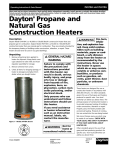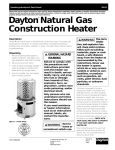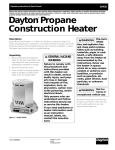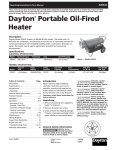Download Dayton 6BY75 Operating instructions
Transcript
6BY75 Operating Instructions and Parts Manual Please read and save these instructions. Read carefully before attempting to assemble, install, operate or maintain the product described. Protect yourself and others by observing all safety information. Failure to comply with instructions could result in personal injury and/or property damage! Retain instructions for future reference. Dayton® Propane Gas-Fired Radiant Construction Heater Description Dayton Model 6BY75 is a 125,000 Btu/Hr construction heater. This heater uses propane gas for combustion. It is primarily intended for outdoor use and the temporary heating of well-ventilated buildings under construction, alteration, or repair. This heater should never be used in occupied dwellings. Products of combustion are vented into the area being heated. Figure 1 - Model 6BY75 Unpacking 1. Remove all packing items applied to heater for shipment. Keep plastic cover caps (attached to valve inlet and hose/regulator assembly) for storage. 2. Remove all items from carton. 3. Check all items for shipping damage. If heater is damaged, promptly inform dealer where you bought heater. Form 5S5381 Fire, burn, inhalation and explosion hazard. Keep solid combustibles, such as building materials, paper or cardboard, a safe distance away from the heater as recommended by the instructions. Never use the heater in spaces which do or may contain volatile or airborne combustibles or products such as gasoline, solvents, paint thinner, dust particles or unknown chemicals. Printed in China 09663 1105/381/VCPVP General hazard warning Failure to comply with the precautions and instructions provided with this heater, can result in death, serious bodily injury and property loss or damage from hazards of fire, explosion, burn, asphyxiation, carbon monoxide poisoning and/or electrical shock. Only persons who can understand and follow the instructions should use or service this heater. If you need assistance or heater information such as an instructions manual, labels, etc. contact the manufacturer. DES004 117164-01 05/05 Rev. B 11/05 6BY75 Dayton Operating Instructions and Parts Manual Dayton Propane Gas-Fired Radiant Construction Heater ® General Safety Information Make certain you read and understand all warnings. Keep these instructions for reference. They are your guide to safe and proper operation of this heater. Safety information appears throughout these instructions. Pay close attention to them. Below are definitions for the safety information listed throughout this manual. Under this heading, installation, operating and maintenance procedures or practices will be found that, if not carefully followed, WILL result in IMMEDIATE serious personal injury or death. Under this heading, installation, operating, and maintenance procedures or practices will be found that, if not carefully followed, COULD result in severe personal injury or death. Under this heading, installation, operating, and maintenance procedures or practices will be found that, if not carefully followed, MAY result in minor personal injury, product or property damage. IMPORTANT: Not every possible circumstance that might involve a hazard can be anticipated. The warnings in this manual and on tags or decals affixed to the unit are therefore not all-inclusive. If a procedure, work method, or operating technique not specifically recommended by Dayton is used, you must make sure it is safe for you and others. You should also ensure that equipment will not be damaged or made unsafe by the operating or maintenance method you choose. Not for home or recreational vehicle use. This product contains and/or generates chemicals known to the State of California to cause cancer or birth defects, or other reproductive harm. Do not exceed 1/2 psi (14" w.c.) gas pressure to the gas control valve. The heater is designed for use as a construction heater in accordance with ANSI Z83.7/CGA 2.14. Other standards govern the use of fuel gases and heating products for specific uses. Your local authority can advise you about these. The primary purpose of construction heaters is to provide temporary heating of buildings under construction, alteration or repair. Properly used, the heater provides safe economical heating. Products of combustion are vented into the area being heated. We cannot foresee every use which may be made of our heaters. Check with your local fire safety authority if you have questions about heater use. Carbon Monoxide Poisoning: Some people are more affected by carbon monoxide than others. Early signs of carbon monoxide poisoning resemble the flu, with headaches, dizziness and/or nausea. If you have these signs, the heater may not be working properly. Get fresh air at once! Check for proper ventilation and have heater serviced. Propane Gas: Propane gas is odorless. An odor-making agent is added to propane gas. The odor helps you detect a propane gas leak. However, the odor added to propane gas may fade. Propane gas may be present even though no odor exists. Make certain you read and understand all warnings. Keep this manual for reference. It is your guide to safe and proper operation of this heater. 1.Install and use heater with care. Follow all local ordinances and codes. In the absence of local ordinances and codes, refer to the Standard for Storage and Handling of Liquefied Petroleum Gas, ANSI/ NFPA 58. This instructs on the safe storage and handling of propane gases. 2.Use only the hose and factory preset regulator provided with the heater. 3.Use only propane gas set up for vapor withdrawal. 4.Provide adequate ventilation. Before using heater, provide at least a 0.35 m2 (3.75 ft2) opening of fresh, outside air. 5.Do not use heater in occupied dwellings or in living or sleeping quarters. 117164-01A Dayton Operating Instructions and Parts Manual Model 6BY75 General Safety Information (Continued) 20.Never move, handle or service a hot or operating heater. Severe burns may result. Wait 15 minutes after turning heater off. 21.To prevent injury, wear gloves when handling heater. 22.Never attach duct work to heater. 23.Do not alter heater. Keep heater in its original state. 24.Do not use heater if altered. 25.Turn off gas supply to heater when not in use. 26.Use only original replacement parts. This heater must use design-specific parts. Do not substitute or use generic parts. Improper replacement parts could cause serious or fatal injuries. 6.Do not use heater in basement or below ground level. 7.Keep appliance area clear and free from combustible materials, gasoline, paint thinner and other flammable vapors and liquids. Dust is combustible. Do not use heater in areas with high dust content. 8.Minimum heater clearances from combustibles: Sides 1.54 m (5 ft), Top 1.22 m Product Identification (4 ft). 9.Keep heater at least 6.0 m (20 ft) from propane tank(s). 10.Keep propane tank(s) Top below 38° C (100° F). 11.Check heater for damage before each use. Do not use a damaged heater. 12.Check hose before each use of heater. If highly Protective worn or cut, replace with Screen hose specified by the manufacturer before using Combustion heater. Chamber 13.Locate heater on stable and level surface if heater is hot or operating. Cover Lighting 14.Not intended for use on Port finished floors. 15.Never block any air inlet or air outlet openings of heater. 16.Keep heater away from Control Knob strong drafts, wind, water Figure 2 - Product Identification spray, rain or dripping water. 17.Do not leave heater unattended. 18.Keep children and animals away from heater. 19.To prevent burns, remove handle before operating heater. 117164-01A 6BY75 Dayton Operating Instructions and Parts Manual Dayton Propane Gas-Fired Radiant Construction Heater ® Specifications • • • • • • • • • Rating: 125,000 Btu/Hr (131,882 kj) Fuel: Propane Vapor Only Fuel Consumption: 5.17 ltr/hr (1.3 gal/hr), 2.6 kg/hr (5.8 lb/hr) Supply Pressure To Regulator (for input adjustment): Maximum 1380 kPa (200 psi), Minimum 138 kPa (20 psi) Manifold Pressure: 2.3 kPa (9.5" W.C.) Heater Weight: 17.69 kg (39 lbs) Shipping Weight: 20.86 kg (46 lbs) Heater Size (L x W x H): 40.6 x 45.7 x 109.2 cm (16" x 18" x 43") Min Temperature: -29 °C (-20° F) Surrounding Air Temperature Theory of Operation The Fuel System: The hose/regu- lator assembly attaches to the propane gas supply. This provides fuel to the heater. The Ignition System: The piezo ignitor lights the burner fuel supply. The Automatic Control System: This system causes the heater to shut down if the flame goes out. Propane Gas Supply Propane gas and propane tank(s) are to be furnished by the user. Use this heater only with a propane vapor withdrawal supply system. See Chapter 5 of the Standard for Storage and Handling of Liquefied Petroleum Gas, ANSI/NFPA 58. Your local library or fire department will have this booklet. The amount of propane gas ready for use from propane tanks varies. Two factors decide this amount. 1. The amount of liquid propane gas in tank(s) 2. The temperature of tank(s) The following chart shows the minimum number of 45 kg (100 lb) tanks needed to run the heater. Connect tanks together with a manifold. Average Temperature Number Of Tanks At Tank Location 45 kg (100 lb) above 0° C (32° F) 2 Below 0° C (32° F) 3 Less gas is vaporized at lower temperatures. Your local propane gas dealer will help you select the proper supply system. Ventilation Provide at least a 0.35 m2 (3.75 ft2) opening of fresh, outside air while running heater. If proper fresh, outside air ventilation is not provided, carbon monoxide poisoning can occur. Provide proper fresh, outside air ventilation before running heater. Installation Test all gas piping and connections for leaks after installation or servicing. Never use an open flame to check for a leak. Apply a mixture of liquid soap and water to all joints. Bubbles forming show a leak. Correct all leaks at once. Read these instructions carefully. Read and adhere to these instructions. Do not allow anyone who has not read these instructions to assemble, light, adjust or operate this heater. Do not attempt to operate the heater with any gas other than that indicated on the heater nameplate. The installation of this appliance must comply with local and/or Provincial codes or, in the absence of these codes, with the National Fuel Gas Code, ANSI Z223.1 – Latest Edition and with the Standard for the Storage and Handling of Liquefied Petroleum Gases, ANSI/NFPA 58 installation codes. This heater (including hose and regulator assembly) must be inspected before each use and at least annually by a qualified service person. If the hose shows evidence of excessive abrasion or wear or if the hose is cut, it must be replaced prior to the heater being put into operation. The replacement hose assembly shall be that specified by the manufacturer. Locating Heater The heater (and propane/LP gas supply cylinder) must be located on a hard, flat, level surface to minimize the risk of accidental tipping. If a propane/LP gas supply cylinder is used, the cylinder should be adequately restrained to prevent accidental 117164-01A Dayton Operating Instructions and Parts Manual Model 6BY75 Installation (Continued) tipping. DO NOT operate this heater with the supply cylinder in any other than the upright position. Keep heater at least 6.0 m (20 ft) from propane tank(s). This appliance must be installed only in locations where the potential for physical damage to the appliance (i.e., due to physical contact) is reduced to a minimum. The installer must inform the owner/operator of this appliance that precautions must be taken to protect the appliance from physical damage. This appliance produces radiant heat. Therefore, it must be located at least 6 feet away from any propane/LP gas container and must not be directed toward any propane/LP gas container within 20 feet. The heater must be installed in a location such that it will not be exposed directly to water spray, rain and/or dripping water. Use of this heater in a draft/ windy area decreases its efficiency. If possible, operate the unit in a draft free area. Connecting to gas supply This model may be connected to a self-contained propane/LP gas supply system using the hose and regulator assembly supplied with the appliance OR, it may be connected to a permanently installed propane/LP gas supply system. If connected to a self-contained propane/LP gas supply system, the hose assembly must be inspected prior to each use of the heater. If it is evident that there is excessive abrasion or 117164-01A wear or if the hose is cut, it must be replaced prior to the heater being put into operation. Never use a fork lift truck type cylinder. The connection to a propane/LP cylinder must be made in a well ventilated area using the regulator and hose assembly supplied with the appliance. DO NOT attempt to adjust this regulator. It has been preset at the factory to provide safe and proper operation of the appliance. Use a 7/8" open end wrench to connect the POL fitting (supplied with the propane/LP regulator) to the propane/LP cylinder. Turn the POL nut in a counterclockwise direction (left hand thread) until tight. DO NOT use pipe compound on POL threads. The heater must be located at least 6 feet away from any propane/LP cylinder and must not be directed toward any propane/LP cylinder within 20 feet. If more than one heater is used, they and the supply cylinders must be separated by at least 20 feet. The gas supply must be turned off at the propane/LP supply cylinder when the heater is not in use. When the heater is to be stored indoors, the connection between the propane/LP supply cylinder and the heater must be disconnected and the cylinder removed from the heater and stored in accordance with Chapter 5 of the Standard for the Storage and Handling of Liquefied Petroleum Gases. ANSI/NFPA 58. If connected to a permanently installed propane/LP supply system, the system requires the use of a two-stage gas regulator assembly which is normally provided by your propane/LP dealer as part of the propane/LP supply system. Consult with your local propane/LP dealer for details concerning proper equipment and installation. Never use a flame for gas leak testing. Operating Instructions If you do not follow these instructions exactly, a fire or explosion may result causing property damage, personal injury or loss of life. This appliance is hot during normal operation, avoid physical contact. Do not place clothing or other combustible materials on this appliance. Handle must be removed before operating heater due to high temperatures. If left in place handle will reach high temperatures and could cause burns. 6BY75 Dayton Operating Instructions and Parts Manual Dayton Propane Gas-Fired Radiant Construction Heater ® Operating Instructions (Continued) DO NOT operate this heater if any part has been under water. Call a qualified service technician to inspect the appliance and to replace any part of the control system or gas control valve which has been under water. Removing Handle 1. Remove wire clip securing handle to top edge of heater. 2. Pull handle upward and away from heater to remove. Set aside for future use. Lighting Heater 1. Before attempting to light the heater, smell all around the heater area for gas. Turn on the gas supply to the appliance and check all fittings and connections for gas leaks using a mild soap and water solution. NEVER use a match to check for gas leaks. Should a gas leak occur, shut off the gas supply to the appliance immediately. Wait a minimum of five minutes before repairing the leak. 2. Use only the fuel intended for this appliance. Check the appliance rating plate for the correct fuel information. 3. Turn the control knob clockwise to the OFF position. See Figure 2, page 3 and Figure 3 for location of appliance parts. 4. Wait a sufficient length of time (at least 5 minutes) to allow gas which may have accumulated in burner compartment to escape. 5. Turn on the main gas supply. 6. Turn control knob counterclockwise to the PILOT position. 7a.Press and turn control knob counterclockwise to PILOT position and hold for 1 to 2 minutes. This may take longer to purge air from supply hose depending on length of the hose being used. Press red spark ignition button to light pilot flame (repeat until pilot lights) and continue to hold control knob at PILOT position for 30-60 seconds to enable pilot light safety system. Fully turn control knob to HI position to light burner. Once heater is lit, check all internal gas connections on unit for leaks (burner, valves, etc.). Never use an open flame to check for a leak. Apply mixture of liquid soap and water to gas joints. Bubbles forming show a leak that must be corrected. Correct all leaks at once. 7b.To match light the pilot, move the lighting hole cover aside (see Figure 3) and place a lighted match into hole. Press control knob and hold while lighting and observing pilot burner. Ensure that pilot burner ignites from match. Allow pilot to burn approximately 30 seconds before releasing control knob. If pilot does not remain lit, repeat lighting operation allowing a longer period of time before releasing control knob. Note: In cases where long runs of gas supply lines have been installed ahead of the appliance, it may be necessary to bleed trapped air out of supply lines before lighting pilot. New installations generally require bleed of supply lines. Wait a minimum of 5 minutes after bleeding supply lines before attempting to light heater. Combustion Chamber Thermocouple Burner Mounting Brace Match Lighting Hole Cover Pilot Assembly Filter Gas Manifold Control knob Figure 3 - Appliance Parts Identification 117164-01A Dayton Operating Instructions and Parts Manual Model 6BY75 Operating Instructions (Continued) Adjust pilot if necessary as noted under Pilot Burner Adjustment. 8. Turn control knob counterclockwise to the ON position. The burner will light. DO NOT operate heater in any position other than full ON. IMPORTANT: DO NOT attempt to adjust the main burner input using the main gas supply valve. This may cause the pilot and thermocouple to shut down the burner. Pilot burner adjustment 1. Remove pilot adjustment cap. The pilot adjustment cap is a slotted screw located in front of the PILOT designation stamped on top of valve body just below control knob. 2. Adjust pilot key to provide properly sized flame. Rotate the key clockwise to decrease flame or counterclockwise to increase flame. 3. Replace pilot adjustment cap. shutting off heater • For short periods of time, turn the main burner off by turning control knob clockwise to the PILOT position. • For extended periods of non use, turn appliance completely off by turning control knob clockwise to the PILOT position, press knob slightly, then turn knob fully clockwise to the OFF position. Turn off gas supply cylinder. 117164-01A 6BY75 Dayton Operating Instructions and Parts Manual Dayton Propane Gas-Fired Radiant Construction Heater ® Troubleshooting Chart Never attempt to service heater while it is connected to propane supply, operating or hot. Severe burns can occur. Symptom Possible Cause Corrective Action Burner fails to light 1.Gas supply valve closed 2.Excess-flow check valve closed 1.Open gas supply valve slowly 2.Close propane supply valve on propane tank and reopen slowly 3.Replace burner orifice 4.Assure ignitor electrode gap is 5.0 mm (0.195"). Check wire lead for damage Replace piezo ignitor and/or ignitor electrode as necessary. Do not bend electrode, this may cause breakage 3.Blockage in burner orifice 4.Piezo ignition system not sparking Pilot lights but goes out when automatic control valve button is released 1.Not enough warm-up time Burn rate is low 1.Main burner valve not fully open 2.Low gas pressure 3.Thermocouple loose or needs to be replaced 4.Automatic control valve needs to be replaced 2.Plugged gas orifices 3.Low gas pressure 4.Low fuel supply 1.Relight, hold automatic control valve button in 45 seconds 2.Check for proper gas supply 3.Tighten connection or replace thermocouple 4.Replace automatic control valve 1.Fully open main burner valve by pushing in control knob and turning counterclockwise towards HIGH position until it stops 2.Replace gas orifice 3.Check gas supply; check regulator output 4.Consult gas supplier to determine adequate supply. Propane/LP tank could be empty 117164-01A Dayton Operating Instructions and Parts Manual Model 6BY75 Cleaning Never attempt to service heater while it is connected to propane supply, operating or hot. Severe burns can occur. 1.Keep heater clean. Clean heater annually or as needed to remove dust and debris. If heater is dirty or dusty, clean heater with a damp cloth. Use household cleaners on difficult spots. 2.Inspect heater before each use. Check connections for leaks. Apply mixture of liquid soap and water to connections. Bubbles forming show a leak. Correct all leaks at once. 3.Inspect hose/regulator assembly before each use. If hose is highly worn or cut, replace. 4.Have heater inspected yearly by a qualified service agency. 117164-01A 6BY75 Dayton Operating Instructions and Parts Manual For RepairPropane Parts, call 1-800-323-0620 Dayton Gas-Fired Radiant 24 hours a day - 365 days a year parts correspondence to: Please provide following information: Construction HeaterAddress Grainger Parts - Model number ® - Serial number (if any) - Part description and number as shown in parts list P.O. Box 3074 1657 Shermer Road Northbrook, IL 60065-3074 U.S.A. 13 21 19 20 23 10 5 4 14 8 22 12 11 3 9 7 18 2 6 17 15 16 1 Figure 4 - Repair Parts Illustration, Model 6BY75 10 117164-01A Dayton Operating Instructions and Parts Manual Model 6BY75 Repair Parts List Ref. No. Description Part Number Qty. 1 104119-01 Manual Control Valve 2 114049-01 Filter/Diffuser 3 114120-01 Pilot Orifice 4 114121-01 Thermocouple 5 114128-01 Pilot Burner 6 114134-01 Hose/Regulator Assembly 7 114244-01 Pilot Supply Tube 8 114153-01 Ignitor 9 102445-01 Piezo 10 114243-01 Spacer 11 114154-01 Axle 12 114156-01 Axle Brackets 13 114157-01 Handle 14 114208-01 Wheel 15 114209-01 Valve Supply Tube Clamp 16 114212-01 Valve Supply Tube 17 114213-01 Burner Manifold 18 114216-01 Burner 19 ** Frame Assembly 20 ** Combustion Chamber 21 ** Top Plate 22 114241-01 Burner Mounting Plate 23 114242-01 Pilot Mounting Bracket /\ 114245-03 General Info Decal /\ 114246-02 Caution Decal /\ 117193-01 Tradename Decal /\ 115297-02 Hang Tag (**) Not a field replaceable part. (/\) Not Shown. 117164-01A 11 1 1 1 1 1 1 1 1 1 1 1 1 1 2 1 1 1 1 1 1 1 1 1 1 1 1 1 Dayton Operating Instructions and Parts Manual 6BY75 Dayton Propane Gas-Fired Radiant Construction Heater ® LIMITED WARRANTY Dayton One-Year Limited Warranty. Dayton Propane Gas-Fired Radiant Construction Heater, Models covered in this manual, are warranted by Dayton Electric Mfg. Co. (Dayton) to the original user against defects in workmanship or materials under normal use for one year after date of purchase. Any part which is determined to be defective in material or workmanship and returned to an authorized service location, as Dayton designates, shipping costs prepaid, will be, as the exclusive remedy, repaired or replaced at Dayton’s option. For limited warranty claim procedures, see PROMPT DISPOSITION below. This limited warranty gives purchasers specific legal rights which vary from jurisdiction to jurisdiction. Limitation of Liability. To the extent allowable under applicable law, Dayton’s liability for consequential and incidental damages is expressly disclaimed. Dayton’s liability in all events is limited to, and shall not exceed, the purchase price paid. Warranty Disclaimer. Dayton has made a diligent effort to provide product information and illustrate the product in this literature accurately; however, such information and illustrations are for the sole purpose of identification, and do not express or imply a warranty that the products are merchantable, or fit for a particular purpose, or that the products will necessarily conform to the illustrations or descriptions. Except as provided below, no warranty or affirmation of fact, expressed or implied, other than as stated in “LIMITED WARRANTY” above is made or authorized by Dayton. Product Suitability. Many jurisdictions have codes and regulations governing sales, construction, installation, and/or use of products for certain purposes, which may vary from those in neighboring areas. While Dayton attempts to assure that its products comply with such codes, it cannot guarantee compliance, and cannot be responsible for how the product is installed or used. Before purchase and use of a product, review the product applications, and all applicable national and local codes and regulations, and be sure that the product, installation, and use will comply with them. Certain aspects of disclaimers are not applicable to consumer products; e.g., (a) some jurisdictions do not allow the exclusion or limitation of incidental or consequential damages, so the above limitation or exclusion may not apply to you; (b) also, some jurisdictions do not allow limitations on how long an implied warranty lasts, consequently the above limitation may not apply to you; and (c) by law, during the period of this Limited Warranty, any implied warranties of implied merchantability or fitness for a particular purpose applicable to consumer products purchased by consumers, may not be excluded or otherwise disclaimed. Prompt Disposition. Dayton will make a good faith effort for prompt correction or other adjustment with respect to any product which proves to be defective within limited warranty. For any product believed to be defective within limited warranty, first write or call dealer from whom product was purchased. Dealer will give additional directions. If unable to resolve satisfactorily, write to Dayton at address below, giving dealer’s name, address, date and number of dealer’s invoice, and describing the nature of the defect. Title and risk of loss pass to buyer on delivery to common carrier. If product was damaged in transit to you, file claim with carrier. Manufactured for Dayton Electric Mfg. Co., 5959 W. Howard St., Niles, Illinois 60714 U.S.A. 117164 01 NOT A UPC Manufactured for Dayton Electric Mfg. Co. Niles, Illinois 60714 U.S.A. 12 117164-01A





















